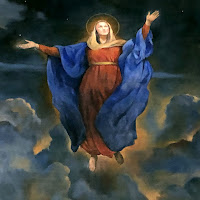One day, while riding her horse, she gave birth to a son, revealing the deception. (Honestly, if she were pope for two years and at the end of that time had a son, then at least one person in her orbit knew that she was actually a woman.) With the deception revealed, she got tied to the tail of the horse, dragged around the city, then stoned to death and buried on the spot with the inscription placed over her Petre pater patrum papissae prodito partum ("Peter, Father of Fathers, betray the childbearing of the woman Pope").
This idea tickled the imagination of others, and so it became repeated and expanded. Along came Martin of Troppau, a Polish Dominican, who also wrote history. His history of the world first appeared during the pontificate of Clement IV (1265-68), but it wasn't until the third edition in 1277 that he added the story of the female pope.
Martin places the event in the 9th century, just after the death of Pope Leo IV (847-55). She was an "Englishman" named John of Mainz. Originally taken to Athens as a young girl in male clothing, she became educated until no one was her intellectual equal. She went to Rome (still disguised as a man), and earned so much respect that she was eventually made pope. During a procession from St. Peter's to the Lateran, she gave birth to a child. She died (and was buried) on the spot. Martin refers to her as Johanna. Martin himself was a papal chaplain at the Vatican, so his accounts were widely read, and the legend spread. In a later version of his history he changed the story, saying that she was deposed, imprisoned, and then lived for many years doing penance. The child grew up to become bishop of Ostia, who had her body interred at Ostia.
Later writers give her the birth name of Agnes; others said she was Gilberta. One version of the story says she was given a vision and offered eternal punishment or temporal disgrace. She chose the latter, and that is why she died on the spot after giving birth.
By the 15th century, scholars were looking at these stories and noting their improbability. Unfortunately, the 20th century enjoys escapism and conspiracy theories, and the legend of "Pope Joan" has been embellished to the point where entire books have been written to recount her "history." There is no gap in the history of popes where Joan was excised (although I wrote here, coincidentally, that one annal thought there was a gap before Leo IV, not after.) A 10th-century pope, John XII (955-64), supposedly had a concubine named Joan who was given much authority at the papal palace during his pontificate, and some have speculated that this gave rise to the idea of a "Pope Joan."
But let's say she did become pope; what was she called? She would not have taken the name "Pope Joan"! A Dominican named Bartolomeo Platina (1421-81) called her Pope John VIII. This is silly, since he should have known that there was a Pope John VIII in the 9th century, and not an inconsequential one, either. Let's talk about him next time.


